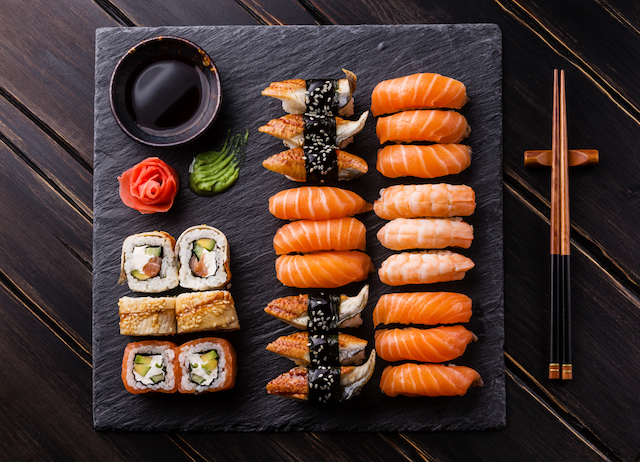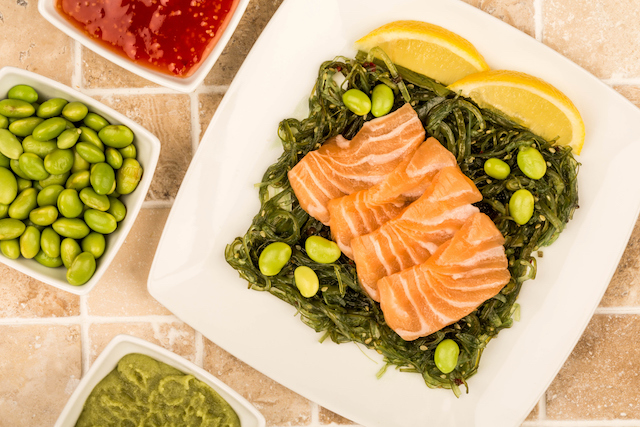Sushi Outlets – How to order a healthy sushi lunch
Written by
on Wednesday, 05 September 2018.
Tagged: eating out, fast food, guides, healthy eating, sushi, tips

In most food courts, you’ll find a sushi outlet with a colourful, tempting display of rolls. Sushi is often seen as a quick, healthy option for that lunch-time rush, with your protein, veggies and rice all in one compact roll. You may be surprised however, to find out that not all sushi rolls are equal and may end up being higher in energy than you think!
The good
- Fish such as salmon, tuna and king fish provide healthy sources of protein. Salmon in particular is rich in omega-3 fats, which helps maintain a healthy heart
- Avocado is also commonly found in sushi rolls, providing a great source of monounsaturated fats (the good fat), as well as vitamin E and folate.
- Edamame beans are a low fat, protein rich side dish, also providing a serve of vegetables!

The not-so-good
- Sushi rolls are carbohydrate heavy
- A typical sushi hand-roll can have around 20g carbohydrates from rice. That’s a little more than a slice of bread. So for those who opt for 3-4 sushi rolls at lunch time, that’s similar to eating over 3-4 slices of bread in terms of carbohydrates.
- Sushi can be high in unhealthy fats
- Tempura and crumbed chicken – Whilst vegetables, chicken and seafood are nutrient dense foods, once they are covered in batter and deep fried, they have a high fat and kilojoule content. This unfortunately, no longer makes them a nutritious option
- Rolls with cream cheese or drizzled in mayonnaise also provide a hefty amount of energy and saturated fat.
- Cooked tuna rolls often have mayonnaise mixed into them too!
- It’s often low in vegetables
- You may get a slice of cucumber here and a piece of lettuce there, but it’s very unlikely your sushi roll will provide even one serve of vegetables.
- If you prefer nigiri (the ball of rice with a slice of fish over the top), there’s virtually no vegetables at all.
- It can be high in salt
- Each little fish-shaped soy sauce that comes with your sushi provides ~ 170mg sodium (~7% recommended daily sodium intake).
- If you’re using a few of these, you can see how it can quickly make for a salty meal, and that’s NOT including the salt in the sushi roll itself.
How to make healthier options

- Opt for 1-2 sushi rolls filled with lean proteins such as raw salmon or tuna and vegetables such as avocado, cucumber or carrot.
- Avoid anything with “katsu” or “tempura” in the name. These are just different ways of naming fried foods.
- Replace a sushi roll with a sashimi plate for a satiating source of protein.
- Try a side of seaweed salad or edamame beans to boost your vegetable intake
- Some sushi outlets offer rice paper rolls, a lower carbohydrate alternative to the traditional sushi roll. They often have more vegetables too.
- Try swapping a white rice for a brown rice roll, providing additional fibre to keep you full.
- Ask for your rolls to be made without mayonnaise. Sushi rolls are often made fresh and sometimes chefs are willing to accommodate.
The bottom line
Sushi can be a quick, healthy lunch time meal, especially when it comes with vegetables and lean proteins such as salmon and tuna.
Your meal however, can quickly become energy, carbohydrate and fat heavy depending on the roll you choose. Tempura, mayonnaise and cream cheese significantly boost the unhealthy fat and calorie content of your meal. Plus, depending on how many rolls you eat, you could be having the equivalent of 3-4 slices of bread!
Use my tips as a guide to help you make healthier options at your local sushi outlet for lunch!
Thanks to dietitian Sophie Feng for this article. You can follow her on Instagram @sophies_foodfeast
Foodwatch
The Good Stuff
The Boring Stuff
© 2025 Foodwatch Australia. All rights reserved
Website by Joomstore eCommerce





